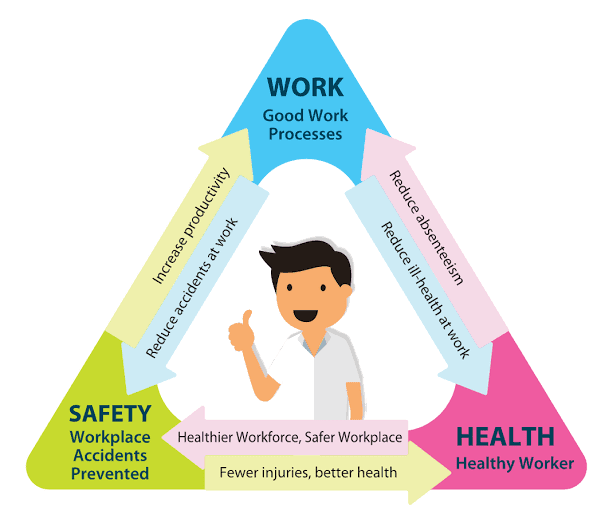
Articles
How Can You Promote Safety in the Workplace?

Safety in the workplace is paramount for any business. It’s not only important to ensure employees are safe, but it also shows that you care about their well-being and value them as part of your team. How can you promote safety in the workplace?
The best way to promote safety in the workplace is by implementing a safety program that will keep everyone informed and aware of potential hazards.
A safe work environment is important not just to ensure employee safety but also to protect employers from costly medical procedures resulting from workplace injuries and hefty fines associated with violations of OSHA regulations.
If you're wondering how can you promote safety in the workplace, read on.
Why is Safety Awareness Important?
Safety awareness is an important part of any workplace. Employees should know the potential risks associated with their job and how to best protect themselves from workplace injuries. A good workplace safety program not only helps keep workers safe but also reduces the risk of costly accidents.
Benefits of a Safe Workplace
A safe workplace is essential for any business. Not only does it keep employees healthy and happy, but it also helps to increase productivity, efficiency, and profits.
Here are some of the main benefits that a safe workplace can bring to your business.
Reduced Risk of Injury: With proper safety protocols in place, the risk of injury or illness among employees will be significantly reduced. This means fewer sick days taken by workers and more time spent on productive tasks.
Increased Productivity: A safe work environment encourages better morale among staff members which leads to increased productivity levels across the board. It also reduces distractions caused by accidents or injuries which can further improve overall performance levels.
Lower Insurance Costs: Having a good safety program in place may help reduce insurance costs as insurers take into account how well you manage health and safety risks when setting premiums for liability coverage policies.
Improved Reputation: A strong commitment to workplace safety shows customers that you care about your workers' well-being. This can lead to improved customer loyalty and an enhanced reputation within the industry or local community.
Better Employee Retention Rates: By creating a safe working environment with clear rules and regulations, employers will find it easier to retain quality staff members who feel valued at their job site.
How Can You Promote Safety in The Workplace?
Safety awareness starts with employers setting a good example by following safety practices and policies themselves. Managers should make sure that all new hires receive proper training on procedures and protocols that promote workplace safety before they start work.
Additionally, employers should provide ongoing education for existing staff members so they stay up-to-date on changes in safety regulations or new technologies that may affect their jobs.
How can you promote safety in the workplace?
Employers can improve workplace safety by creating a culture where everyone takes responsibility for their own safety as well as others around them. This means encouraging open communication between supervisors and employees about any concerns related to workplace safety issues such as identifying hazards or reporting unsafe conditions in the workplace.
Conduct regular meetings to increase safety awareness and get everyone on board with the company's workplace safety program.
Incentives are another great way to encourage employee buy-in when it comes to promoting safety programs in the workplace. Companies can offer rewards such as gift cards or extra vacation days for those who consistently follow safety measures while at work. This will show employees that you value their commitment to keeping themselves (and others) safe while working.
Finally, employers need to take action if there are any violations of occupational safety rules or procedures — even minor ones — so that employees understand the seriousness of implementing safety measures at work. Taking disciplinary action against those who do not comply with safety practices sends a clear message about your expectations when it comes to worker protection.
Establishing a Safety Culture
To ensure that safety programs are taken seriously in the workplace, it’s important to establish a culture of safety by defining your safety goals and developing policies and procedures.
Defining Your Safety Goals
Establishing clear goals for employee safety should be the first step in establishing a culture of safety in the workplace. These goals should include specific objectives such as reducing accidents or injuries on the job or improving compliance with health and safety regulations. Once these goals have been established, they can be used to measure progress and help guide decision-making related to employee safety.
Developing Policies and Procedures
Developing comprehensive policies and procedures around employee health and safety is essential for ensuring that everyone understands their roles when it comes to maintaining a safe work environment. This includes outlining expectations for behavior on the job as well as providing detailed instructions on how to use equipment safely or respond during emergency situations. Having these policies written down makes them easier to enforce across all departments.

Identifying Potential Hazards
The first step to creating a safe workplace is risk assessment.
Assessing the Workplace Environment
To maintain a safe work environment, it is important to regularly assess the workplace for potential hazards. This includes evaluating areas such as lighting, temperature, ventilation, and noise levels. If any of these factors are not up to standard, it can create a hazardous situation for employees.
Look for physical obstacles that could cause an accident or injury such as uneven flooring or exposed wiring.
Evaluating Equipment and Machinery
All equipment and machinery should be regularly inspected to ensure it is functioning properly and safely. Look for signs of wear and tear that could lead to malfunctions or breakdowns — resulting in accidents or injuries. Make sure all safety guards are in place on machines so they cannot be bypassed by employees who may be tempted to take shortcuts when operating them.
Supervisors should monitor workers closely to ensure that proper safety protocols are being followed at all times. This will help reduce the risk of accidents caused by employee negligence.
Implementing Protective Measures
Providing Adequate Safety Training and Resources
It is essential to ensure that all employees are adequately trained on safety protocols. This includes providing them with the necessary resources such as manuals, videos, or other materials that explain how to safely operate equipment and machinery.
Additionally, employers should provide refresher courses periodically to remind employees of proper safety procedures.
Establishing Emergency Protocols
Employers should also establish emergency protocols in case of an accident or injury. These protocols should include a plan for medical attention, evacuation, and contact information for first responders. Employees should be familiarized with these protocols so they know what to do in the event of an emergency situation.
Finally, it is important that employees wear personal protective equipment (PPE) every time they enter the floor. PPE can help protect workers from hazardous chemicals or extreme temperatures by providing insulation against these elements. Employers must make sure that their employees have access to the right type of PPE for their job and that they understand how to properly use it at all times.
Conclusion
How can you promote safety in the workplace? By establishing a safety culture, identifying potential hazards, and implementing protective measures, businesses can ensure that their employees are safe and protected.
Workplace safety should be taken seriously by all members of the organization as it not only protects workers but also helps promote productivity and morale.
Promoting safety in the workplace is essential for businesses to grow and scale. Investing in effective onboarding, offboarding, and training experiences can help ensure that employees understand company policies and procedures as well as their own responsibilities when it comes to safety.
Trainual provides an easy-to-use platform with customizable templates that makes documenting processes and policies simple so you can be confident your business is operating safely. Let’s work together to create a safe working environment — sign up for Trainual today!
Similar Blog Posts







